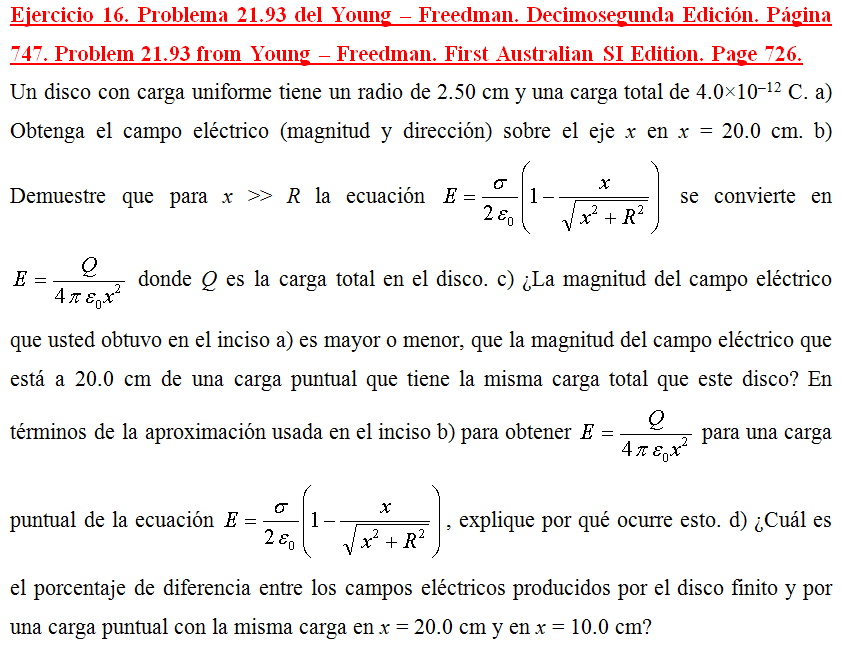Description
Problema 21.93 del Young – Freedman. Decimosegunda Edición. Página 747.
Problem 21.93 from Young – Freedman. First Australian SI Edition. Page 726.
Un disco con carga uniforme tiene un radio de 2.50 cm y una carga total de 4.0×10–12 C. a) Obtenga el campo eléctrico (magnitud y dirección) sobre el eje x en x = 20.0 cm. b) Demuestre que para x >> R la ecuación  se convierte en
se convierte en ![]() donde Q es la carga total en el disco. c) ¿La magnitud del campo eléctrico que usted obtuvo en el inciso a) es mayor o menor, que la magnitud del campo eléctrico que está a 20.0 cm de una carga puntual que tiene la misma carga total que este disco? En términos de la aproximación usada en el inciso b) para obtener
donde Q es la carga total en el disco. c) ¿La magnitud del campo eléctrico que usted obtuvo en el inciso a) es mayor o menor, que la magnitud del campo eléctrico que está a 20.0 cm de una carga puntual que tiene la misma carga total que este disco? En términos de la aproximación usada en el inciso b) para obtener ![]() para una carga puntual de la ecuación
para una carga puntual de la ecuación  , explique por qué ocurre esto. d) ¿Cuál es el porcentaje de diferencia entre los campos eléctricos producidos por el disco finito y por una carga puntual con la misma carga en x = 20.0 cm y en x = 10.0 cm?
, explique por qué ocurre esto. d) ¿Cuál es el porcentaje de diferencia entre los campos eléctricos producidos por el disco finito y por una carga puntual con la misma carga en x = 20.0 cm y en x = 10.0 cm?
A uniformly charged disk has radius 2.50 cm and carries a total charge of 4.0×10–12 C. (a) Find the electric field (magnitude and direction) on the x-axis at x = 20.0 cm. (b) Show that for x >> R, Eq.  becomes
becomes ![]() where Q is the total charge on the disk. (c) Is the magnitude of the electric field you calculated in part (a) larger or smaller than the electric field 20.0 cm from a point charge that has the same total charge as this disk? In terms of the approximation used in part (b) to derive
where Q is the total charge on the disk. (c) Is the magnitude of the electric field you calculated in part (a) larger or smaller than the electric field 20.0 cm from a point charge that has the same total charge as this disk? In terms of the approximation used in part (b) to derive ![]() for a point charge from Eq.
for a point charge from Eq.  , explain why this is so. (d) What is the percent difference between the electric fields produced by the finite disk and by a point charge with the same charge at and at x = 20.0 cm.
, explain why this is so. (d) What is the percent difference between the electric fields produced by the finite disk and by a point charge with the same charge at and at x = 20.0 cm.



Reviews
There are no reviews yet.